Back
to Newsletter List
____________________
Summer
2008 Newsletter
Waldensian
Presbyterians, Valdese, NC — Saturday, October 11
Did you know that the Waldensian
Church is the oldest evangelical church in existence, having
begun 350 years before the Reformation? And did you know
that a group of Waldenses came from Italy to North Carolina
in 1893 and founded the town of Valdese? It is unusual
to hear of Italian Presbyterians, but we will learn much more
about them at our fall meeting on Oct. 11.
The name Waldenses
or Waldensian comes from Peter
Waldo, a wealthy merchant in
Lyons in the south of France, who gave up his property in 1177
and began to preach publicly about apostolic poverty and the
personal interpretation of the scriptures. At first accepted
by the Roman Church, they were declared to be heretics in 1184.
Many were burned at the stake, and there followed centuries
of persecution
Nonetheless, the church
had preachers, both men and women, who traveled secretly
and met with congregations in homes. The movement survived
primarily in the secluded valleys of the Cottian Alps between
France and Italy. When the Reformation took hold in
Europe, the Waldensian churches voted to align themselves with
the reformers in Switzerland, led by John
Calvin. They
had a long tradition of translating parts of the Bible, and
they assisted Calvin in producing the first complete Bible
in French.
In 1685 the French king
revoked the Edict
of Nantes, which had granted religious
freedom, and sent an army into the Valleys. Many
were massacred or died in prison. Those who converted
to Catholicism were sent to other parts of Italy or forced
to be galley slaves. However,
some made the dangerous journey over the mountains to Switzerland.
Four years later, William
of Orange sent troops to help them regain the valleys.
This “Glorious
Return” is celebrated in Valdese with a festival every
August.
In
1694 the Duke of Savoy granted them religious freedom, and
in 1848 the Waldensians were finally granted their civil
liberties as well. With
peace came prosperity and increased numbers – more than
could be supported in the small Alpine valleys. Groups
left to settle in South Africa, South America, and the U.S. Eleven
families were the first group to come to North Carolina, arriving
in 1893. They formed the Valdese Corporation
and purchased about 10,000 acres to be held in common. More
families came in the next few years.
In 1895 they voted to unite
with the Presbyterian Church, U.S. The Romanesque-style church
building was begun in 1897 and completed in 1899. Among
themselves, the people spoke a patois based on Old French,
and Sunday services were in French, except for one service
a month in Italian. In their homeland it was most unusual
to find a family who had not memorized at least one book
of the New Testament, based on their fear that persecution
might deprive them of the written word. In America
they continued the practice of having children memorize one
chapter of the Bible.
The land was not as fertile
as they had hoped, so the corporation was dissolved. A hosiery
mill, sawmill, and cotton mill were soon opened, as well as
the Waldensian Baking Company, now part of Sara Lee. People
of other backgrounds moved into Valdese and established their
own churches, but the town is still proud of its heritage.
A play, From This Day Forward, was written for the
75th anniversary of the town and has since become an outdoor
drama presented at Valdese each July and August. Next
to the church is the excellent Waldensian Museum, which belongs
to the congregation and which we will tour at the beginning
of our meeting
For centuries the Waldenses made wine
in their homes. In
1986 a cooperative winery was formed, whose staff and workers
are all volunteers. It is located in a barn built about
1930 from fieldstone. After our business meeting, there
will be an optional tour of the winery, which has next to it
a covered bocce or boccia court (Italian lawn bowling).
As an alternative to the winery tour or
as an added attraction afterwards, you may wish to walk the Trail
of Faith,
which begins at the Trail of Faith Visitors Center, 401 Church
St. There are 15 replica buildings and exhibits illustrating
the life of the people in Europe and during the early years in
North Carolina. It will be open that Saturday from 2:00
to 5:00 p.m.
_______________
Need a ride to Valdese?
Our treasurer, Earl Fitzgerald, will be receiving the registrations
for our meeting. If you need a ride, he may be able to
put you in touch with someone who could pick you up. His telephone
number is 919-876-6665, and his email address is efitzge@intrex.net.
For directions, see map below.
_______________
President’s
Column
Presbyterian Heritage Center in Montreat Open
With a choir’s Korean
words of “What a Friend we have in Jesus” and
a piper’s playing of “Amazing Grace,” spectators
gathered at the entry to the old Historical Foundation on
Saturday, May 24, 2008. After an invocation, and welcoming
remarks from John Richardson, on behalf of the Montreat Conference
Center, PHC board chairman Richard Ray cut the ribbon across
the door and the new Heritage Center officially opened to
visitors.
Clouds
that had threatened showers gave way to sunshine as some
200 visitors lined up to sign in and view two exhibits marking
the opening: the centennial of the great Korean revival
of 1907, and a celebration of 100 years of Montreat history.
Spence Hall holds a blend
of the new and the familiar. From the ceiling of the lobby
now hang flags, colorfully representing some of the countries
with a Presbyterian missionary presence. The old reading
room has been reopened, and additional resources are being
added. Habitués of the old Historical Foundation
will be pleased to spot the wood carvings by the Rev. John
Mack Walker, Jr., depicting scenes from the Gospels, still
on display. Freeland Hall remains closed; it
will be converted into meeting space.
Already available in the
display area are a few PHC-sponsored publications in its
Heritage Series: pamphlets on “Historic Churches of Old
Mecklenburg County” and “Research at the Presbyterian
Heritage Center.” More are undoubtedly on the way.
The staff, headed by director
Ron Vinson, includes a number of volunteers and part-timers.
The Center is already open many hours more per week than the
Historical Foundation was toward its demise.
Perhaps most interestingly,
for those who cannot get to Montreat very often, a lively
Web site, www.phcmontreat.org/ ,
highlights a wide variety ways the Center is fulfilling is
mission, and provides links for those wanting more information
on numerous topics relating to Presbyterian heritage. Tax-deductible
contributions to the PHC’s ongoing growth can also
be made on line. The Center relies on individual, foundation,
and local congregational support.
I hope sometime soon the
Society can schedule a meeting in or near Montreat, to let
our members see what has been happening and to show our support
for this new work. Meanwhile, everyone hopes that the
many summer conference attendees will not miss seeing this
exciting new project celebrating our Reformed heritage.
Don Saunders
_______________
Election of Officers
At our Annual Meeting this
fall, an election will be held for two offices: First
Vice-President, who serves as Program Chair; and Third Vice-President,
who serves as Awards Chair. Mrs. Ann Myrhe has agreed
to serve a second two-year term as Awards Chair if elected.
Suggestions are welcome for the position of Program Chair.
Any member may make a nomination from the floor.
Officers
Dr. Donald B. Saunders, President
P.O. Box 1846, Blowing Rock, NC 28605
Phone: (828) 295-8917
E-mail: saundersdb@appstate.edu
Brenda Spence, Secretary
294 Fairway Lane, Sanford, NC 27332
Phone: (919)-498-2159
E-mail: tom-brenda@charter.net
Ann Myhre, Awards Chair
1005 Park Ave., Garner, NC 27529
Phone: (919) 772-5514
E-mail: ann@wrpc.org
Sally MacLeod Owens, Membership Chair
710 North Person Street #204
Raleigh, NC 27604-1276
Phone: (919)-835-0920
Col. John Wray, Program Chair
2113 Yorkgate Dr., Raleigh, NC 27612
Phone: (919) 782-3384 or 787-9754
coljohnwray@earthlink.net
Earl Fitzgerald, Treasurer
2213 Foxhorn Road
Trent Woods, NC 28562
Phone: (919)876-6665
E-mail: efitzge@intrex.net
Barbara T. Cain, Newsletter Editor
1041 Shelley Road, Raleigh, NC 27609
Phone: (919)-782-0944
E-mail: btcain@nc.rr.com
Thomas K Spence, Past President
294 Fairway Lane, Sanford, NC 27332
Phone: (919)-498-2159
E-mail: tom-brenda@charter.net
_____________
Last Spring in New
Bern
Photographs by John B. Gordon
| |
|
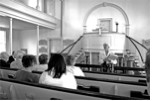 |
|
|
First
Presbyterian Church ,
New Bern |
We all really enjoyed our
tour of historic churches in New Bern last April. The
weather was great and the gardens lovely. As a port
city, New Bern has had a rich and varied history from the
colonial period to the present day, and each place of worship
brought out a different aspect of that history. The
meeting began in the sanctuary of the First Presbyterian
Church with its central high pulpit, completed in 1822. Donald
Taylor told us about its antebellum history, when many free
blacks and slaves were members along with the white townspeople.
During the Civil War, New Bern was occupied by Union troops
and the church became a hospital. The building was in poor
condition by the end of the war, but the congregation survived
as an integrated body until 1878, when First Church helped
to organize a separate church for colored Presbyterians.
| |
|
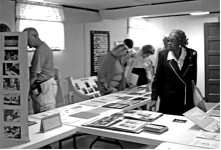 |
|
|
Mrs.
A. B. Bryant and
the historical display at Ebenezer |
That congregation, Ebenezer
Presbyterian, was our second host church on Friday afternoon.
Ebenezer’s
first building was destroyed by the Great Fire of New Bern
in 1922. Its present brick structure was built by its
members. Rev. Robert Johnson and Mrs. A.B. Bryant spoke
about its history and work, and then led us to the Fellowship
Hall. There we were greeted by other members and found
a wonderful display about the church’s history, filling
the whole room. It was hard to pull ourselves away in
time for supper!
After dinner Mr. Victor Jones of the
New Bern Public Library told us about the Palatines, who
were the very first settlers at New Bern. The evening closed
with beautiful and moving songs of praise by Mrs. Martha
Johnson and Sister Mildred LaBoo.
Saturday
morning we were met bright and early by Mr. Pete Killingsworth
at Croatan Presbyterian Church, between New Bern and Havelock.
The frame church, built in 1884, has a columned belfry and
hand sawn decorative trim around the outside. Several
times the congregation has declined after economic changes,
but once again it is growing as new families move into the
area.
| |
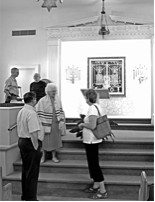 |
| Mrs.
A. B. Bryant and the historical display at Ebenezer |
Our next stop was Temple
B’Nai Sholem, where Mrs. Barbara Beck met us. Jewish
merchants lived and worshipped in New Bern for many years
before the synagogue was built in 1908. A Reformed
congregation, they have a strong tradition of lay leadership.
Across the street is Old St. Paul’s, the oldest Catholic
church in North Carolina, organized in the home of William
Gaston.
On the next corner is Centenary
Methodist, the second oldest congregation in New Bern, having
begun in 1772. The present curved sanctuary is surrounded
by beautiful stained glass windows from Germany. Mr. Larry
Lovvorn, our host, also showed us the lovely chapel and baptismal
font.
| |
|
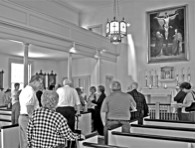 |
|
|
Old
St. Paul's Catholic Church |
Just down the road we
were met by Mr. David Skaggs in front of Christ Church, established
in 1715. In the old cemetery the foundations of the original
church are marked, with stone seats inside its space. The
present building was built in 1871 and is almost identical
to the 1824 structure, destroyed by fire. Inside we saw
the silver communion service and Bible given by King
George II.
Finally, at First Baptist,
we were greeted by the son of our long-time members Earl
and Penny Fitzgerald — Rev. Steven Fitzgerald. Baptists
have a long history in New Bern, beginning in the 18th century.
The building itself dates from 1848 and was also occupied
by Union troops during the Civil War. The congregation
is very active in the community.
Lunch at Morgan’s in
downtown New Bern was followed by a brief business meeting,
during which Mrs. Ann Myrhe announced that awards were given
for two books: Pioneer
Presbyterians: Rev. Colin McIver and Rev. John D. McFarland by
Rev. John H. Jackson and Mrs. Bess Lane; and Journey to
New Hope: The History of new Hope Presbyterian Church, 1756-2006 by
Barbara A. Murphy, M.D. This brought an end to our formal
meeting, but many members stayed a while to visit the gardens
of Tryon Palace or one of the museums or historic houses.
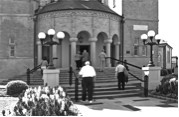 |
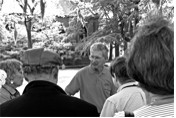 |
|
Centenary
Methodist Church |
David
Skaggs, Christ Episcopal |
Sister
Mildred LeBoo |
_____________
Where
did all the Historical Foundation materials go?
In 2006, the General Assembly of the
Presbyterian Church (USA) voted to close the Montreat Office
of the Presbyterian Historical Society, which had formerly
been known as the Historical Foundation for the Presbyterian
and Reformed Churches, Inc. It was decided that the large
collection of church archives, manuscript materials, photographs,
books, microfilm, and artifacts that were housed there would
be divided among three repositories. Your
editor has been trying to find out what went where, and how
to access them. The following is my report.
1. Presbyterian Historical Society Contact: Reference
Desk
425 Lombard Street, Philadelphia PA 19147
Telephone (215) 627-1852
Fax (215) 627-0509
http://www.history.pcusa.org
If
you are trying to locate something that you know was at Montreat,
the first place to call should be the Presbyterian Historical
Society in Philadelphia. Their
in-house archives database contains the list that was made
of all the materials removed from Montreat and where each
item or collection was sent. The reference
staff will search that database and tell you, for example,
whether a church’s
records were sent to Columbia, Philadelphia, or were returned
to the church, but not whether the church then sent them
to another repository. Unfortunately,
they have no plans to make that list openly available to patrons
there or on-line, as they say it is too large. About
60% of the materials moved from Montreat went to Philadelphia
and the rest to Columbia. The artifacts
were not included in the database.
The Historical Society in
Philadelphia has long been the repository for all records
of the UPUSA General Assembly and boards, as well as those
of its predecessor organizations. It also
has the records from the UPUSA synods and presbyteries, as
well as many from local congregations. Therefore the materials
sent to Philadelphia from Montreat include the following:
- records of the PCUS General Assembly and its national boards,
- most of the manuscript collections of missionaries sent
out by the Southern church,
- all synod records,
- records of those congregations and presbyteries that did
not ask to have their records returned or sent to Columbia,
- the histories compiled by Presbyterian Women at the presbytery
level,
- the collection of rare Bibles,
- and artifacts from missionaries and others that related
to the work of the church.
I was told that many of the records and
collections sent to Philadelphia have already been cataloged
in Calvin, but they are not identified as having come from
Montreat. [Editor’s Note:
It is common practice for archives to include a note in the
catalog record about previous custody, but the PHS leadership
have made a point of not doing so — even though it would
be helpful for a researcher to know that a collection or artifact
is indeed the one that was previously at Montreat.] The
Montreat finding aids for the manuscript collections are being
converted to a standard format so they can be available on-line.
2. Columbia Theological Seminary
Special Collections,
John Bulow Campbell Library,
701 S Columbia Dr., Decatur, GA 30030
(404) 378-8821
http://www.ctsnet.edu/Library.aspx
Contact: Ms.
Chris Paton, Archivist
(404) 687-4628
E-mail: PatonC@CTSnet.edu
Hours: 8:30
a.m.- 4:30 p.m., M-F
Ms. Chris Paton (pronounced Payton) is the new Special
Collections archivist at Columbia, working specifically with
the materials that came from Montreat. She has a very good background
as a reference archivist and was very helpful. The materials they received
from Montreat include the following:
- local church histories written by Presbyterian Women nation-wide,
- vertical files concerning local churches that were formerly
PCUS,
- records of those congregations and presbyteries that chose
to send them to Columbia,
- personal papers not related to the national church bodies,
- sermons,
- and some artifacts, most of which are either from a specific
congregation or are related to one of the collections of
personal papers.
The printed books from Montreat,
including church histories, are being added to the seminary
library and will be in their on-line catalog. In Special
Collections they are compiling a list of the congregational
records first and then will move on to the personal papers.
They did receive an electronic database from Philadelphia
containing the list of what was sent to them, but they don’t
have the software to retrieve the data. The on-line
catalog at Columbia had also been named “Calvin,” but
it is a different system that is not compatible with the
Calvin catalog in Philadelphia. Because
they are working to identify and verify everything they have
received, the Special Collections area for the time being
may be visited by appointment only, and only on Fridays.
However, they are glad to help you and will reply promptly
to all questions that come in by telephone, email, or letter.
The library actively acquires by donation
similar collections and/or additions to existing collections.
The books and personal papers are owned by the seminary;
the congregational and presbytery records are on deposit.
3. Presbyterian Heritage Center,
Montreat Contact: Mr.
Ron Vinson
PO Box 207, Montreat, NC 28757
828-669-6556
http://www.phcmontreat.org/
I
had a very helpful conversation with Ron Vinson, director of
the PHC. They
are completely independent of the Presbyterian Historical Society
in Philadelphia (PHS) and are dedicated to providing the
greatest possible access to their collections. They are digitizing
many of their unique holdings with help from Princeton University,
and they hope to make these items available and searchable
on-line before long. Princeton
has been digitizing huge numbers of their books, and the PHC
will be able to provide patrons with access to everything
Princeton has digitized. The
present collection at the PHC includes
- reference books on Presbyterian history,
- printed records of the Presbyterian
Church and minutes of the General Assembly from 1706 to
present,
- rare denominational & other periodicals,
- materials relating to the history
of Montreat, including manuscript collections,
- a large collection of photographs,
- some maps,
- microfiche, including
–
records of the
Board of Foreign Missions
–
Reformation texts, 1500-1700
- most of the artifacts, including
– the
collection of communion tokens
– the wood carvings of Rev.
John Mack Walker, Jr.
– the cultural artifacts from missionaries
– all the military
chaplain artifacts
The Heritage Center does not have
a list of the items and collections that were left there after
other materials were sent to Philadelphia and Columbia. At
present they are busy creating a database of all their artifacts,
which they hope to complete by the end of the year. A
different cataloging system will be needed for the books and
collections, and they hope to one in place and available on-line
in the near future.
I was interested to learn that the PHC
is very interested in building up the collection at Montreat.
They cannot take the official records of any church or church
body, which, according to the Book of Order, must be kept
either at the Presbyterian Historical Society or at a seminary
with adequate facilities, or by the church body itself. However,
Philadelphia took almost all the personal letters and papers
of missionaries, even though they were not official reports.
Also, many of the printed histories of individual churches
and the vertical files on churches were sent to Columbia.
The PHC would like to rebuild its collection of printed church
histories, and they are collecting Presbyterian manuscripts,
letters, and documents, including those of missionaries, as
long as they are not official records.
Barbara Cain
NCPHS Newsletter Editor
_____________
North Carolina Presbyterian Historical
Society
Fall Meeting: October 11, 2008
Waldensian Presbyterian Church
Valdese, NC
Saturday, October 11
8:45-9:45 Registration and Coffee,
Fellowship Hall
10:00 Tour
of Waldensian Museum (across the side street from the church)
11:30 Morning
Speaker: Mr. John Bleynat
“History
of the Waldensians and the Presbyterian Church in Valdese”
12:30 Lunch,
Fellowship Hall
1:20 Annual
business meeting, Fellowship Hall
2:00 Optional
local tours
– Waldensian
Heritage Winery
– Trail
of Faith
(Or, check out your own options for Friday
or Saturday at www.valdese.com )
__________
Registration: $17.50 per person
(includes lunch, museum admission, etc.)
Rooms for Friday night have
been set aside for us until Sept. 20 at the Sleep
Inn, I-40 at Morganton, Exit 105, at the special price
of $51.99 + tax.
Telephone 828-433-9000 and
tell them this is for the NCPHS meeting. Do book your room
in time, as our meeting will be during the fall color season
in the mountains.
Directions
to Valdese:
From the east: Take Exit 112 and turn
right onto Eldred Street. At Main St. E. (Hwy. 70),
turn left, pass two stoplights, and you will see the
church on your left.
From the west: Take Exit
111. Turn right at Millstone Avenue, right at Carolina Street,
and then left on Main Street East. The church is on your
left in the second block.
Map:
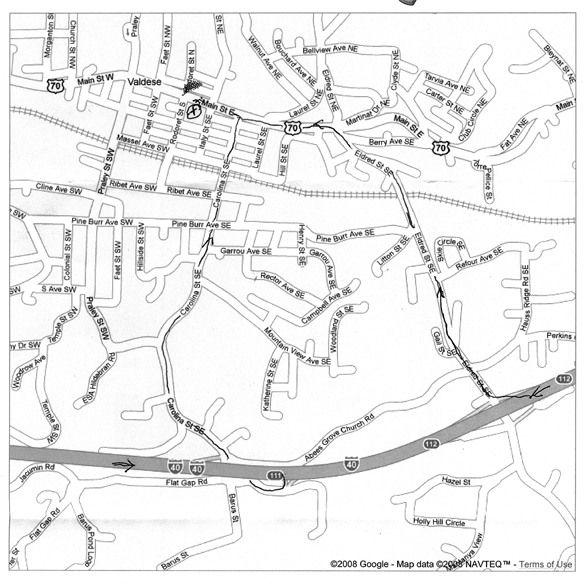
To register, please
mail the form below and a check (payable to NCPHS) by
October 1 to
our treasurer Earl Fitzgerald, 2213 Foxhorn Road, Trent Woods,
NC 28562. (Phone: 919-876-6665)
- - - - - - - - - - - - - - - - - - - -
- - - - - - - - - - - - - - - - - - - - - - - - - - - - - - -
- - - - -
Registration: (Please
print legibly)
Name(s): ________________________________________________________
Address: ________________________________________________________
Telephone: ______________________
Email:___________________________________________________________
No. of registrations
____ @ $17.50 = $ __________
Dues (Individual
$10; Family $15; Individual Life Membership, $100): $__________
Total enclosed: $__________
Please send this
form with your check (made out to NCPHS) by October 5th to Mr.
Earl Fitzgerald, 2213 Foxhorn Road, Trent Woods, NC 28562.
__________
If
you can do so, please put the following announcement in your
church bulletin or newsletter:
The North Carolina Presbyterian Historical
Society will hold its Fall Annual Meeting in Valdese on Saturday,
October 11. We will be learning about the
French-speaking families from Northern Italy, members of
the ancient Waldensian Church, who founded Valdese
in 1893 and became Presbyterians! They have an excellent museum,
a bakery, a bocce court, and a cooperative winery! For
more information or to register, please go to our website
at www.ncphsociety.org,
or contact Don Saunders, (828) 295-8917, email: saundersdb@appstate.edu.
Back
to Newsletter List

